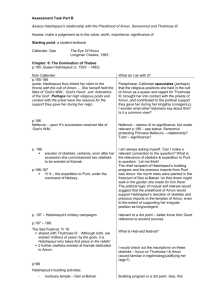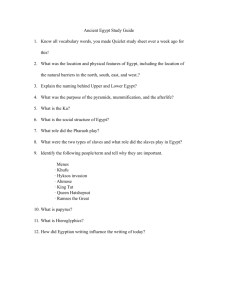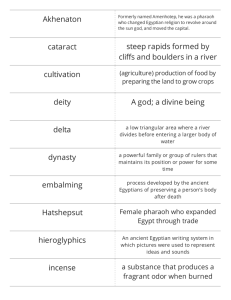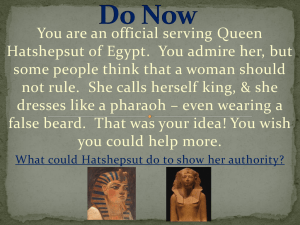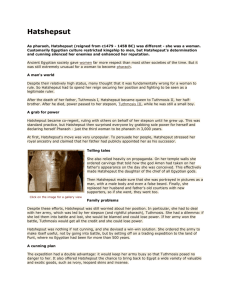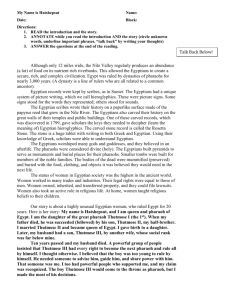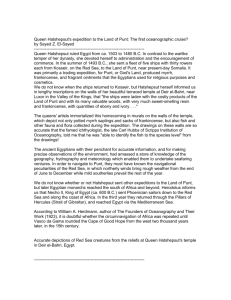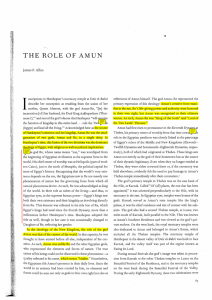GESTOSO SINGER (Gr.), « The Obelisks of Hatshepsut
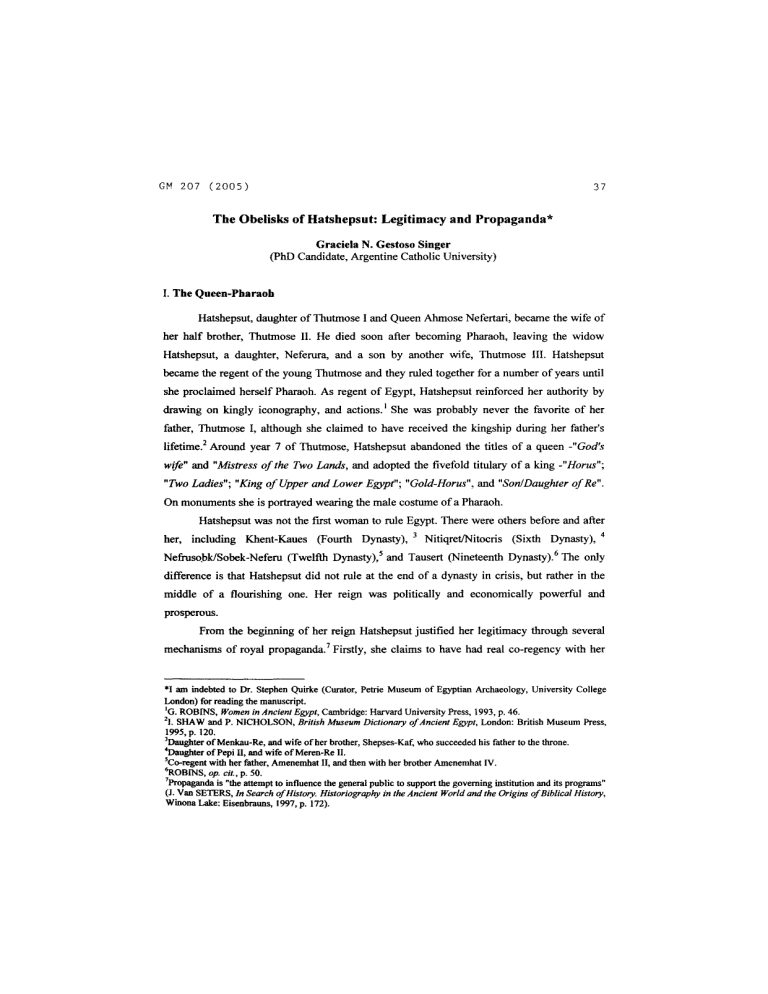
GM 207 ( 2005)
The Obelisks ofHatshepsut: Legitimacy and Propaganda*
Graciela N. Gestoso Singer
(PhD Candidate, Argentine Catholic University)
37
I. The Queen-Pharaoh
Hatshepsut, daughter of Thutrnose I and Queen Ahrnose Nefertari, became the wife of her half brother, Thutrnose II. He died soon after becoming Pharaoh, leaving the widow
Hatshepsut, a daughter, Neferura, and a son by another wife, Thutmose III. Hatshepsut became the regent of the young Thutmose and they ruled together for a number of years until she proclaimed herself Pharaoh. As regent of Egypt, Hatshepsut reinforced her authority by drawing on kingly iconography, and actions.
1
She was probably never the favorite of her father, Thutrnose I, although she claimed to have received the kingship during her father's lifetime.
2
Around year 7 of Thutrnose, Hatshepsut abandoned the titles of a queen -"God's wife" and "Mistress of the Two Lands, and adopted the fivefold titulary of a king -"Horus";
"Two Ladies"; "King of Upper and Lower Egypt"; "Gold-Horus", and "Son/Daughter of Re".
On monuments she is portrayed wearing the male costume of a Pharaoh.
Hatshepsut was not the first woman to rule Egypt. There were others before and after her, including Khent-Kaues (Fourth Dynasty),
3
Nitiqret/Nitocris (Sixth Dynasty),
4
Nefruso.bk/Sobek-Neferu (Twelfth Dynasty),
5 and Tausert (Nineteenth Dynasty).
6
The only difference is that Hatshepsut did not rule at the end of a dynasty in crisis, but rather in the middle of a flourishing one. Her reign was politically and economically powerful and prosperous.
From the beginning of her reign Hatshepsut justified her legitimacy through several mechanisms of royal propaganda.
7
Firstly, she claims to have had real co-regency with her
•1 am indebted to Dr. Stephen Quirke (Curator, Petrie Museum of Egyptian Archaeology, University College
London) for reading the manuscript.
2
'G. ROBINS, Women in Ancient Egypt, Cambridge: Harvard University Press, 1993, p. 46.
1. SHAW and P. NICHOLSON, British Museum Dictionary of Ancient Egypt, London: British Museum Press,
1995, p. 120.
3
Daughter ofMenkau-Re, and wife of her brother, Shepses-Kaf, who succeeded his father to the throne.
4
Daughter ofPepi II, and wife ofMeren-Re II.
5
Co-regent with her filther, Amenemhat II, and then with her brother Amenemhat IV.
~OBINS,
7
Propaganda is "the attempt to influence the general public to support the governing institution and its programs"
(J. Van SETERS, In Search of History. Historiography in the Ancient World and the Origins of Biblical History,
Winona Lake: Eisenbrauns, 1997, p. 172).
38 father, Thutmose I. In Pylon VIII of the Karnak temple and on the XIth northern column, her father is depicted expressing his gratitude to Amun for giving kingship to both of them. The support of the priesthood of Amun was very important to the ascent of Hatshepsut and her staying in power. Hapuseneb was the High Priest of Amun and she put him in charge of her monuments at Karnak.
Her name and epithets underline her need for legitimacy:
Ma'at-ka-Re- 'Truth/Order is the Spirit ofRe'
Hatshepsut-Khenemet-Amun- 'Foremost of Female Nobles, Joined With Amun':
In the inscription of the temple called by the Greeks Speos Artemidos,
8 south ofBeni
Hassan, Hatshepsut describes herself as "the one predestined' by an oracle of Amun to restore all the temples and to return order ("maat") to Egypt after the chaos that was brought about by the Hyksos: "Hear ye, all people and the folk as many as they may be. I have done these things through the counsel of my heart. I have not slept forgetfully, but I have restored that which had been ruined. I have raised up that which had gone to pieces formerly, since
the Asiatics were in the midst of Avaris in the Northland ( ... ). They ruled without Re, and he did not act by divine command down to the reign of my Majesty. Now I am established upon the thrones of Re".
9
The reliefs in her mortuary temple at Deir el-Bahri depict her divine birth, the support of Amun, and her right to rule. At the "Birth Colonnade"
10
Hatshepsut claims to be the physical daughter of Amun (who replaced Thutmose I in his body) and Queen Ahmose.
Finally, the goddess Hathor offers the baby to Amun and announces her as the "King" of
8
K. SETHE, Urkunden der 18. Dynastie, Leipzig: J.C. Hinrich'sche Buchhandlung, 1906, fV, 383-391 (the complete inscription).
9
/bidem, 390, 2-12 (the original version); J.A. WILSON, "Egyptian Historical Texts", in PRITCHARD, J.B.
(ed.), Ancient Near Eastern Texts relating to the Old Testament, Princeton/New Jersey: Princeton University
1
Press, 1969, p. 231 (for the translation).
~.
NAVILLE, The Temple of Deir ei-Bahari, London: Kegan Paul, 1896, Part II, 46-55 (Egypt Exploration
Fund Memoir, 14); J.H. BREASTED, Ancient Records of Egypt. Historical Documents, Chicago: The University of Chicago Press, 1906, vol.ll, §§ 187-212.
39
Egypt. The temple of Hathor annexed to the Mortuary Temple at Deir el-Bahri describes the childhood of Hatshepsut.
11
The cow-goddess Hathor is carrying and kissing her, with Apis, the bull god, following them. Hatshepsut is seen visiting the temples of Atum (in Heliopolis),
Hathor (in Thebes), and Khnum (in Elephantine) with her father, Thutmose I, and she is named and hailed as the future "King".
A second series of scenes shows the coronation of Hatshepsut.
12
These describe
Amun's choice of her as the future ruler, including the full coronation ritual on New Year's day during her father's lifetime. Hatshepsut visits Heliopolis, where she is designated crown princess and co-ruler by her father, Thutmose I. In fact, in other monuments she claims to be
"ruler of Egypt" only after the death of her husband, Thutmose II, and as co-regent of
Thutmose III. The text ofthe coronation ceremony itself seems to be a copy from the account of Amenernhet III's coronation during the Middle Kingdom.
13
The past is used as a medium for political propaganda, when a specific event from the past, such as the visit to Heliopolis with her father, is related to her claim for divine election.
In another set of reliefs from Deir ei-Bahri she records the expeditions to Punt,
14
Byblos and Sinai, all ofthem important providers of luxury goods and raw materials. There is also a record of the transport of two obelisks from As wan to Karnak.
15
Finally, Hatshepsut ordained the erection of four obelisks in the temple of Amun at
Karnak in order to make public her actions of government and to reinforce her legitimacy to rule.I6
II. The Obelisk inscriptions
The obelisk, Egyptian t!Jn, 17 is a four-sided single piece of stone standing upright, gradually tapering as it rises and terminating in a small pyramid called a "pyramidion".
Originally, it was probably an amorphous stone set upright to represent the benben on which
11
Urk., IV, 381, 15.
12
NAVILLE,
1
'Yan SETERS,
14
1t was op. cit., 1898, Part III, 56-64; BREASTED, op. cit., 1997, p. 175. op. cit., II,§§ 215-242. a land rich in products Egypt needed, such as myrrh, frankincense, sweet-smelling resin, aromatic trees, ebony, ivory, and gold. Cf. NA VILLE,
1
'BREASTED,
16 op. cit., II,§§ 322-329. op. cit., III, 69-86; Urk., IV, 315-354 (for the Expedition to Punt).
Urk.,IV, 356-373.
17
Wb. V, 326, 15-24; L. HABACHI, The Obelisks of Egypt. Skyscrapers of the past, London: J.M. Dent & Sons,
1977 • PP· 3-4; S. QUIRKE, passim.
The Cult of Ra: Sun-worship in Ancient Egypt, London: Thames and Hudson, 200 I,
40 the rays of the rising sun first fell at the dawn of creation. The primordial benben was at the temple of Re at Heliopolis and was believed to represent the petrified semen of Atum-Re.
Benben stones were associated with solar gods (Re or Re-Harakhti, the rising sun, and Atum, the setting sun), and with the benu-bird (Phoenix) as well.
The obelisks were connected with the solar cult of Re, whose main center was at
Heliopolis (Eg. lwnw, "the pillar"). There are also associated with other gods and goddesses, such as Amun-Re, Shu, Re-Harakhti, Isis, Khnum, Osiris, Neith, Ptah, Thoth, Atum, Khepri, and Mnevis. During the New Kingdom, the obelisks were most often erected in pairs, flanking the entrance of a temple. The sides were carved with reliefs and inscriptions commemorating important events in the reign of the pharaoh. Special emphasis is laid on the quarrying, transport and erection of the obelisks.
Hatshepsut erected four obelisks of pink Aswan granite in the temple of Amun at
Karnak, from which only two remain in situ. Inscriptions were carved on the four sides of the shaft and the basis.
18
In general, the inscriptions emphasize her devotion to Amun and to
Thutmose I, the legitimacy of her reign, the political and economical power of her rule, and the universality of her dominion ("circuit of Aten"). In the following, a translation of the best preserved northern obelisk is presented in full.
19
1. Shaft inscriptions
The shaft inscriptions are dedicated to: a) her election as "king" by Amun, and b)
Amun and Thutmose I, her divine and earthly father, respectively.
Hatshepsut employs three solar attributes"Son ofRe", "Mistress of the circuit of Aten
(the solar disc)", and "Shining image of Amun" - which are related to Heliopolis in Lower
Egypt; Amarna in Middle Egypt, and Thebes in Upper Egypt, respectively. Both Masculine and feminine designations are used in the text "Son of Re", "Son of Isis", "Son of Nut";
"Daughter of Re", "Daughter of Amun-Re", "Mistress of the circuit of Aten". Titrough this
18
R. LEPSIUS, Denlaniiler aus Aegypten und Aethiopen. Text, Leipzig: J.C. Hinrichs'sche Buchhandlung, 1900,
III, 22-24; SETHE, Urkunden ... ,IV, 356-373 (for the publication of the obelisks); BREASTED, op. cit., II,§§
308-321 (for the translation of the northern and southern obelisks); M. LICHTHEIM, Ancient Egyptian
Literature, Berkeley/Los Angeles: University of California Press, 1976, vol. II, pp. 25-29 (for the northern one, except for the later additions to the shaft).
19
Urk., N, 356-359 (for the shaft inscriptions); 361-369 (for the basis inscriptions).
41 gender duality she seeks to justify her legitimacy as "Queen-Pharaoh". Since in Egyptian ideology there is no place for a female king, she had to adopt male titles and attributes. a) Southside
"Horus, mighty of Ka's; King of Upper and Lower Egypt, Maatlmre, Shining image of Amon, whom he made appear as king upon the throne of Horus, in front of the holies of the palace; whom the Great Ennead nursed to be 'Mistress of the circuit of Aten'.
20
They have endowed her with life, dominion, and joy in front of the living; the Son of Re,
Hatshepsut Khenemet-Amun, beloved
21 of Amun-Re, King of Gods, given life like Re forever." b) Westside
"Horus, mighty of 1m's; Two Ladies, flourishing in years; Gold-Horus, divine of diadems; King of Upper and Lower Egypt, Lord of the Two Lands, Maatlmre. She made (it) as her monument for her father Amun, Lord of Thrones of the Two Lands, erecting for him two great obelisks at the august portal,
22
(named) "Amun is great in Majesty." Wrought with very fine electrum, they illuminate the Two Lands like Aten. Never was the like made since earth's beginning. Made for him (Amun) by the Son of Re, Hatshepsut Khenemet-Amun, given life like Re forever." c) Northside
"Horus, mighty of Ka's; Two Ladies, flourishing in years; Gold-Horus, divine of diadems; King of Upper and Lower Egypt, Lord of the Two Lands, Maatlmre. Her father
Amun has established her great name upon the august ished-tree.
23
Her annals are millions of title "nbt .l'nw n itn" (Urk., N, 357, 14) denotes the universality of her rule. During her reign Aten, the sun disk, was considered a deity.
21
The Egyptian verb mr(l), translated usually as "beloved', is used here to denote "being elected'. See J .M.
GALAN, El imperio egipcio. Jnscripciones, ca. 1550-1300 a. C., Barcelona: Trotta, Ediciones de Ia Universidad
2 de Barcelona, 2002, p. 62, note 2.
23
~
The ished-tree, identified as the persea, is the so called "tree of life" on which Amun lL'Id other gods record the royal titulary and the number of regnal years of each pharaoh. It was associated with the sun-god and with the
42 years, united with life, stability, and dominion. The Son of Re, Hatshepsut Khenemet-Amun, beloved of Amun-Re, King of Gods, is [the builder of this beautiful monument] which she made for him on the first occurrence of the jubilee,
24 so that she will have life forever." d) Eastside
"Horus, mighty of Ka's; King of Upper and Lower Egypt, Maatkare, beloved of
Amun-Re. Her majesty has recorded the name of her father on this enduring monument.
Favor was shown to the King of Upper and Lower Egypt, Lord of the Two Lands,
Aakheperkare (Thutmose I), by the majesty of this god, when these two great obelisks were erected by her majesty on the first occurrence.
25
The Lord of the Gods said: "Your father, the
King of Upper and Lower Egypt, Aakheperkare, gave instruction to erect obelisks,
26 and your majesty (Hatshepsut) shall multiply monuments, so as to live forever."
2. Base inscriptions
The base of the standing obelisk contains an inscription of thirty-two horizontal lines.
It emphasizes a) the exaltation of the royal person; b) the earthly and divine events connected with the erection of the monuments; c) the devotion of Hatshepsut to Amun-Re and to
Thutmose I; d) the legitimacy and universality of her power. a) Southside: Laud of the Queen
27
(1) "The Living Horus, Mighty of Ka's; Two Ladies, Flourishing in years; Gold-Horus,
Divine of Diadems; King of Upper and Lower Egypt: Maatkare; Daughter of Re:
Hatshepsut Khenemet-Amun, who lives forever. The daughter of Amun-Re, his beloved, his only one who came from him; shining image of the Lord of all; whose beauty was fashioned horizon. See Wb. I, 136, 5 ff.; R. FAULKNER, A Concise Dictionary of Middle Egyptian, Oxford: Oxford
University Press, 1991, p. 31;
24
The Sed Festival (Eg.l,zb-sd)
Urk., N, 591, 16; 597, 14. is a ceremony of renewal and regeneration of the king's power. See Wb. III, 59, 9;
FAULKNER,
25 op. cit., \991, p. 167.
This refers to the queen's jubilee. I prefer Breasted's"on the first occurrence"- (op. cit., 11, § 311, p. 129), over Lichtheim's
2 ~s
-"for the first time" (op. cit.,
27
The base inscription begins on the south side, p. 26). See also note 24.
Karnak in
Pylon ofTuthmose I (see BREASTED, op. cit., II,§§ 86 ff.). correlation with the location of Thebes, the residence of Amun and the Queen. This section contains the exaltation of Hatshepsut and the dedication of the obelisks to Amun.
43 by the Souls 28 of On (Heliopolis); 29 who holds the Two Lands like her maker;
30 whom he created to wear his diadems; who has forms like Khepri, who rises like Harekhti; pure egg, splendid seed, whom the Two Magicians
31 nursed; whom Amun himself made appear upon the throne of Southern On (Thebes );
32 whom he chose as guardian of Egypt, as protector of nobles
33 and commooers.
34
The Horus who championed her father, the eldest (daughter) of
Kamutef; 35 (5) whom Re begot to have beneficent offspring on earth, for the well-being of mankind. His living image, the King of Upper and Lower Egypt, Maatlwre, the electrum of kings."
Dedication of the Obelisks
"She made (them) as her monument for her father Amun, Lord of Thrones of the Two
Lands, presiding over lpet-sut (Karnak), making for him of two great obelisks of hard granite of the South,
36 their upper side being of electrum, of the best of all foreign lands. Seen on both sides of the river, their rays flood the Two Lands when Aten rises between them, as he dawns in the horizon of heaven."
28
Lit. b3w 'lwmv, "The Souls of On", i.e. "of the ancient kings". See FAULKNER, op. cit., 1991, p. 77; Urk, IV,
361, 9; Wb. I, 413, 6.
29
Eg. 'Jwmv, the "pillar", or 'Jwmv m}Jt, the "northern pillar". Cf. FAULKNER, op. cit., 1991, p. 13; Wb. I, 54,
6.
30
Lit. ir-sw, "He who made him", i.e. "his father". Cf. BREASTED, op. cit., II,§ 314, p. 130.
31
Lit. wrt-}Jk3w, "the two who are great in magic", i.e. the goddesses Isis and Nephtis. Cf. Urk., IV, 361, 15; 566,
2; Wb. I, 328, l l.
32
Eg. W3st, "the scepter" or 'lwmv sm 'w, "the southern pillar" or" Heliopolis of the South". See FAULKNER, op.
cit., 1991, pp. 13; 54; Wb. I, 259, 20; 260, 1-2.
33
Lit. p't (cf. also Urk., IV, 157, 17; 249, 3), variously translated as "people", "men" (Wb.l, 503); "patricians";
"mankind'' (FAULKNER, op. cit., 1991, p. 88; A. GARDINER, Egyptian Grammar, Oxford: Oxford University
Press, 1982, p. 565); "men from the ruling class" (A. GARDINER, Ancient Egyptian Onomastica, I, London:
Oxford University Press, 1947, 18*); "military elite" (D. LORTON, "Legal and Social Institutions of Pharaonic
Egypt", in SASSON, J.M., (ed.), Civilizations of the Ancient Near East, I, New York: Charles Scribner's Sons,
1995, pp. 351-352). Cf. R. FLAMMINI- G. N.GESTOSO, "Los Himnos a Sesostris Ill", Aegyptus Antiqua II
(2003 ): 28,
34
Lit. nn. 15-16.
r!Jyt, "common folk"; "people" (GARDINER, op. cit., 1982, p. 578; Wb. II, 447,9 ff.); "subjects of king";
"common folk" (FAULKNER, op. cit., 1991, p. 152). Cf. Urk., IV, 17, 8; 133, 8.
35
Lit. "Bull of his mother", which signifies the role of Amun as progenitor of all creation. See QUIRKE, Ancient
Egyptian Religion, London: British Museum Press, 1992, pp. 76-77. Cf. also G. HAENY, "Zum Kamutef', GM
3
90 (1986): 33-34.
44 b) Westside: Speech ofthe Queen
37
"I have done this
38 with a loving heart for my father Amun; I have entered upon his project of the first occurrence. 39 Acquainted with his beneficent might, I did not forget anything he had ordained. My majesty knows his divinity. I acted under his command; it was he who led me. I did not plan a work without his doing; (10) it was he who gave directions. I did not sleep because of his temple; I did not stray from what he commanded. My heart was
Sia
40 before my father, I entered into the plans of his heart. I did not turn my back to the city of the All-Lord, rather did I tum my face to it. I know that Ipet-sut (Karnak) is the horizon on earth, the august hill of the beginning, the Sacred Eye of the All-Lord, his favored place that bears his beauty and gathers in his followers."
The king himself says: "I declare before the people
41 who shall be in the future; who shall observe the monument I made for my father; who shall speak in discussion; who shall look to posterity. It was when I sat in the palace, and thought of my maker, (15) that my heart led me to make for him two obelisks of electrum, whose summits would reach the heavens, in the august hall of columns, between the two great portals
42 of the king, the Strong Bull, King
Aakheperkare (Thutmose I), the Horus triumphant. Now my heart turns to and from, in thinking what will the people say." c) Northside: Oath to posterity
43
"0 ye people, who shall see my monument in after years and shall speak of what I have done, beware o~ saying: 'I do not know, I do not know, why this has been done, (and) a mountain fashioned entirely from gold like something that just happened'."
37
Here the queen begins to speak in the flJ'St person. The west side inscription reflects the devotion of the queen to her dead father, Thutmose I, and to Amun.
38 l.e., the obelisks.
3
"Lichtheim (op. cit., p. 27) renders this phrase as "Initiated in his secret of the beginning", but I believe that the
Sed-festival is meant here.
<Ooeification of the concept of "knowledge", "perception".
41
For rm[, "people", see FAULKNER, op. cit., 1991, pp. 149-150; Wb. II, 421, 9 ff.. For similar expressions in the "Gebel Barkal Stela" see G. GESTOSO et alii, La Estela de Gebel Bar/cal de Tuthmosis Ill, Buenos Aires:
Bib los, 1996, p. 17, lines 33
42
43
If.
1.e., the Pylons IV and V built by Thutmose I.
The north side inscription includes an oath to the next generations in order to remember and perpetuate her name forever.
45
"I swear
44
as I am loved of Re, as Amun, my father, favors me, as my nostrils are refreshed with life and dominion, as I wear the white crown, as I appear with the red crown, as the Two Lords
45 have joined (20) their portions for me, as I rule this land like the Son of
Isis (Horus), as I am mighty like the Son of Nut (Osiris), as Resets in the evening bark, as he rises in the morning bark, as he joins his two mothers in the god's bark, as sky endures, as his creation lasts, as I shall be eternal like an undying star, as I shall rest in life like Atum- so as regards these two great obelisks, wrought with electrurn by my majesty for my father Amun, in order that my name endure in this temple forever and ever, they are each of one block of hard granite, without seam, without joining together."
"My majesty began work on them in year 15, second month of winter, day 1, ending in year 16, fourth month of summer, last day, and totaling seven months of quarry work." d) Eastside: The past as propaganda
46
(25) "I did it for him out of affection, as a king for a god. It was my wish to make them for him, gilded with electrurn. I laid their side on their body. I expect people to say my mouth is effective in its speech, (since) I do not go back on my word. Hear ye! I gave for them of the finest electrum and I measured it by the gallon
47 like sacks of grain. My majesty summoned a quantity beyond what the Two Lands had yet seen. The ignorant and the wise know it."
"Let not him who shall hear it say, 'It is a lie' what I have said; rather say, 'How like her it is; she is devoted to her father!'. The god Amun, Lord of Thrones of the Two Lands, knows me well. He made me rule (30) the Black Land and the Red Land as reward. No one rebels against me in all lands; all foreign lands are my subjects. He placed my border at the limits of heaven; what Aten encircles
48 labors for me.
49
He gave it to him,
5° who came from
44
For a similar oath. see the Aswan inscription of Thutmose II (BREASTED, op. cit., II, 121, 10), and the
Megiddo Campaign ofThutmose lii (ibidem, II, 422, 40; LICHTHEIM, op. cit., 1976, p. 31).
•sLit nbwy, "the Two Lords", i.e. "Horus and Seth" (FAULKNER. op. cit., 1991, p. 129). Cf. also Urk., IV, 16, 9;
138, 3).
46
The east side inscription refers to her right to rule and the universality of her domains.
47
Lit. I:Uf;Jt (Urk., IV, 367, 15), a com measure of 4.54 litres (GARDINER. op. cit., 1982, pp. 197-198, § 266, I;
FAULKNER. op. cit., 1991, p. 178; Wb. III, 174, 13). Cf. var. Urk., IV, 429, 12; 720, 7; 756, 8.
48
The expression "What the sun disc (Aten) encircles (snnt itn)" (Wb. IV, 490, 7) defines the Pharaonic domains.
SeeM. LIVERANI, Prestige and Interest. International Relations in the Near East ca. 1600-1100 B.C., Padova:
4
Sargon Sri, 1990, p. 52; GALAN, op. cit., 2002,65 ff.
"For the expression b3k n, "work for (someone)", see Wb. I, 426, 3 ff.; Urk., IV, 96, 10; 132, 5. soLe., the queen herself.
46 him, knowing I would rule it for him. I am his daughter in very truth, who serves him, who knows what he ordains. My reward from my father is life, stability and rule on the Horus throne of all the living, like Re, forever."
III. Conclusion
Hatshepsut, the only full-fledged female Pharaoh in the Eighteenth Dynasty, had to overcome many obstacles in her quest for legitimacy. She had to surmount potential threats of revolt, to win over the support of both elites and commoners, and to protect her rule in face of the growing influence of her nephew Thutmose III.
To achieve these goals Hatshepsut launched a multi-faceted propagandistic campaign addressing various aspects of her rulership:
On the ideological level she claimed to be not only the favorite daughter of her charismatic father, Thutmose I, but also the physical daughter of Amun-Re. In doing this she took up an old tradition from the Fourth Dynasty, when Khent-Kaues, daughter of Menkau-
Re, married a priest ofRe claiming divine origin from the god Re himself.
5
1
With regard to foreign policy she initiated an ambitious political and economical program directed towards the south, as opposed to the traditional northeastern orientation of her predecessors. Following once again an Old Kingdom tradition (the southern expedition of the Fifth Dynasty king Sahure), she sent out a mission to Punt (in southern Sudan or Eritrea) guided by Amun-Re and Hathor, the "Lady of Punt".
52
The expedition returned with ships laden with gold, ivory, ebony, animal hides, myrrh and perfumes. Establishing direct links with these remote regions was a great step in the economic organization of Egypt. Also, the control of raw materials and prestigious goods,
5
3 and the transport of exotic trees,
5
4 such as myrrh and persea (ished), and their replanting in Egypt
55 had, besides economic advantages an important ideological role related to the Egyptian control of"chaos" in the foreign lands.
5 'ct:
H. ALTENM0LLER, "Auferstehungsritual und Geburtsmythos", SAK 24 (1997): 1-21.
52
Urk., IV, 323, 5; 324, I (for "Hathor, the Lady of Punt" in the inscription of the Expedition to Punt). Cf. n. 55.
53
LIVERANI, op. cit., 1990, p. 244; R. FLAMMINI, Biblos y Egipto durante Ia dinastia XII, Buenos Aires, 1996,
5 If. (CEEMO: Series Monogrtijicas, I); R. FLAMMINI- G. GESTOSO SINGER, "Hathor y las Regiones
Extranjeras durante el Reino Medio Egipcio", Sty/os 10 (2001): 18-20 (for the relationship between Hathor and raw materials from foreign lands).
54
LIVERANI, op. cit., 1990, p. 246, nn. 27-29 (for Egypt and Punt); A.L. OPPENHEIM, "On Royal Gardens in
Mesopotamia", JNES 24 (1965): 328-333 (for Assyria).
55
Hatshepsut decides to "establish for him (Amun) a Punt in his house" (Urk., IV, 353, 2), planting myrrh trees in the courtyard of the temple (LIVERANI, op. cit., 1990, p. 246, n. 27).
47
Finally, to commemorate her achievements on the occasion of the Sed Festival,
5
6
Hatshepsut transported from Aswan two granite obelisks to the temple of Amun at Karnak
57 and carved on them an inscription which reveals her needs of government: legitimacy, general consensus, and reinforcement of the socio-economical system. As texts of royal propaganda, the obelisk inscriptions of Hatshepsut emphasize her divine election by Amun; the legitimacy of her "kingship", and the universality of her dominion.
56
During the 15dt -16th years of Hatshepsut, two obelisks were quarried, transported, and erected on the occasion of her first jubilee. Cf. O'MARA, P. F., "Was the Sed Festival Periodic in Early Egyptian History? (1)",
Discussions in Egyptology
57
See note 15.
JJ ( 1988): 27.
